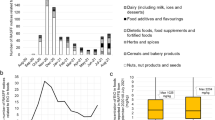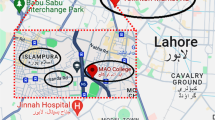Abstract
It has been strongly suggested that two factors are involved in the development of Kaschin–Beck Disease (KBD), namely grains contamination with T-2 toxin and selenium deficiency. So our team undertook a survey about grains and drinking water in three rural KBD endemic villages and one non-KBD village in Qinghai Province. The level of T-2 toxin contamination in 364 grain samples was assayed using an ELISA kit. The selenium concentration in these grains and 15 drinking water samples from three KBD endemic villages were determined using the 2,3-diaminonaphthalene fluorometric assay. The results revealed that the level of T-2 toxin contamination in the samples from three KBD endemic villages was relatively high with an average level of 78.91 ng/g in wheat and 47.47 ng/g in flour. The T-2 toxin level in samples from the non-KBD village (12.23 ng/g) was significantly lower than that of local grains from the three KBD endemic villages. The average selenium content in wheat and flour from KBD areas was 0.0045 and 0.0067 μg/g, respectively. The selenium concentration in local grain samples was significantly lower than that in samples from the non-KBD village (0.0604 μg/g). In addition, the selenium concentration in drinking water from three KBD endemic villages was also low (0.156 μg/L). These results support a potential role of T-2 toxin contamination and selenium deficiency in KBD. Compared with non-KBD endemic areas, health hazards in grains and in the environment of KBD endemic areas were observed.




Similar content being viewed by others
References
Cao J, Li S, Shi Z et al (2008) Articular cartilage metabolism in patients with Kaschin–Beck disease: an endemic osteoarthropathy in China. Osteoarthritis Cartilage 16:680–88
Zhao ZJ, Li Q (2005) Study on cartilage damage affected by T-2 toxin on patients with Kaschin–Beck disease. Chin J Control Endem Dis 20:23–26
Lv SQ, Wang LJ, Wang ZL (2000) T-2 Toxin and Kaschin–Beck disease. Chin J Control Endem Dis 15:35–39
Li S-y, Cao J-l, Shi Z-l et al (2008) Promotion of the articular cartilage proteoglycan degradation by T-2 toxin and selenium protective effect. J Zhejiang Univ Sci B 9:22–33
Yang JB (1995) A research report on the etiology of KBD. Chin J Endemiol 14:201–05
Nascimento J, Nunes VA, Guedes RM et al (2001) T-2 toxin and disturbed endochondral bone growth in broiler chicken. Arq Bras Med Vet Zootec 53:332–40
Rosenstein Y, Lafarge-Frayssinet C (1983) Inhibitory effect of fusarium T-2 toxin on lymphoid DNA and protein synthesis. Toxicol Appl Pharmacol 70:283–88
Fu YT, Lin WG, Cheng ZB et al (2001) The effect of T-2 toxin on IL-1 β and IL-6 secretion in human fetal chondrocytes. International Orthopaedics 25:199–201
Wang LH, Fu Y, Shi YX et al (2011) T-2 toxin induces degenerative articular changes in rodents: link to Kaschin–Beck disease. Toxicologic Pathology 39:502–07
Ge K, Yang G (1993) The epidemiology of selenium deficiency in the etiological study of endemic diseases in China. Am J Clin Nutr 57:259 S–63 S
Peng A, Yang C, Rui H et al (1992) Study on the pathogenic factors of Kaschin–Beck disease. J Toxicol Environ Health 35:79–90
Li SJ, Yang LS, Li YH et al (2006) Relationship between the content of selenium in grains and the Kaschin–Beck disease in Tibet, China. Chin J Endemiol 6:73–74
Li SJ, Yang LS, Wang WY et al (2006) Study on the relationship between selenium concentrations in drinking water and Kaschin–Beck disease in Tibet. Chin J Endemiol 25:428–29
Zhang B, Yang L, Wang W et al (2011) Environmental selenium in the Kaschin–Beck disease area, Tibetan Plateau, China. Environ Geochem Health 33:495–501
Li Q, Zhao ZJ, Wen H (2004) Effective observation on children KBD control with three different methods of selenium supplement in guide endemic area, Qinghai. Endemic Disease Bulletin 19:62–64
Zhang A, Cao JL, Yang B et al (2010) Effects of moniliformin and selenium on human articular cartilage metabolism and their potential relationships to the pathogenesis of Kaschin–Beck disease. Zhejiang Univ-Sci B (Biomed & Biotechnol) 11(3):200–208
Liu QB, Liu XH, Zhang JX et al (2002) The effect on exchanging grain prevent Kaschin–Beck Disease in Hulunber region of Inner Mongolia. Chin J Endemiol 21:117–19
Yang JB (1988) The effect on exchanging grain prevent Kaschin–Beck disease in Qian County, Fusong County and Shuangyashan City. Chin J Endemiol 7:230–33
Zhaxi SZ, Baima CW, Xirao RD et al (2002) Effect observation on prevention and treatment of Kaschin–Beck disease in Tibet Autonomous Region. Chin J Control Endem Dis 22:130–32
Mngadi PT, Govinden R, Odhav B (2008) Co-occurring mycotoxins in animal feeds. Afr J Biotechnol 7:2239–43
Ueno Y (1984) Toxicological features of T-2 toxin and related trichothecenes. Fundam Appl Toxicol 4:S124–32
Yang JB (2002) Mycotoxins and human diseases. Chin J Endemiol 21:314–17
Scientific Committee for Food Opinion of the Scientific Committee on Food on Fusarium toxins. Part 5: T-2 toxin and HT-2 toxin (adapted on 30 May 2001). http://europa.eu.int/ comm/food/fs/sc/scf//out88.
Peng A, Wang Y, Wang W et al (1987) Inhibitory effect on the toxicity of fusarium toxin by selenium. Acta Scien-tiae Circumstantiae 7:237–39
Peng A, Wang Z, Wang W et al (1991) A new hypothesis for the etiology of Kaschin–Beck disease. J Environ Sci (China) 3:5–14
Author information
Authors and Affiliations
Corresponding author
Additional information
Li-Yan Sun and Qiang Li contributed equally to this work.
Rights and permissions
About this article
Cite this article
Sun, LY., Li, Q., Meng, FG. et al. T-2 Toxin Contamination in Grains and Selenium Concentration in Drinking Water and Grains in Kaschin–Beck Disease Endemic Areas of Qinghai Province. Biol Trace Elem Res 150, 371–375 (2012). https://doi.org/10.1007/s12011-012-9469-7
Received:
Accepted:
Published:
Issue Date:
DOI: https://doi.org/10.1007/s12011-012-9469-7




